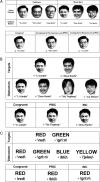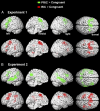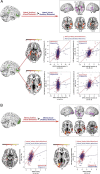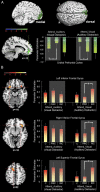Vision dominates at the preresponse level and audition dominates at the response level in cross-modal interaction: behavioral and neural evidence
- PMID: 23616521
- PMCID: PMC6619562
- DOI: 10.1523/JNEUROSCI.1985-12.2013
Vision dominates at the preresponse level and audition dominates at the response level in cross-modal interaction: behavioral and neural evidence
Abstract
There are ongoing debates on the direction of sensory dominance in cross-modal interaction. In the present study, we demonstrate that the specific direction of sensory dominance depends on the level of processing: vision dominates at earlier stages, whereas audition dominates at later stages of cognitive processing. Moreover, these dominances are subserved by different neural networks. In three experiments, human participants were asked to attend to either visual or auditory modality while ignoring simultaneous stimulus inputs from the other modality. By manipulating three levels of congruency between the simultaneous visual and auditory inputs, congruent (C), incongruent at preresponse level (PRIC), and incongruent at response level (RIC), we differentiated the cross-modal conflict explicitly into preresponse (PRIC > C) and response (RIC > PRIC) levels. Behavioral data in the three experiments consistently suggested that visual distractors caused more interference to auditory processing than vice versa (i.e., the typical visual dominance) at the preresponse level, but auditory distractors caused more interference to visual processing than vice versa (i.e., the typical auditory dominance) at the response level regardless of experimental tasks, types of stimuli, or differential processing speeds in different modalities. Dissociable neural networks were revealed, with the default mode network being involved in the visual dominance at the preresponse level and the prefrontal executive areas being involved in the auditory dominance at the response level. The default mode network may be attracted selectively by irrelevant visual, rather than auditory, information via enhanced neural coupling with the ventral visual stream, resulting in visual dominance at the preresponse level.
Figures






Similar articles
-
Loss of Vision Dominance at the Preresponse Level in Tinnitus Patients: Preliminary Behavioral Evidence.Front Neurosci. 2019 May 14;13:482. doi: 10.3389/fnins.2019.00482. eCollection 2019. Front Neurosci. 2019. PMID: 31139048 Free PMC article.
-
Enhancement of visual dominance effects at the response level in children with attention-deficit/hyperactivity disorder.J Exp Child Psychol. 2024 Jun;242:105897. doi: 10.1016/j.jecp.2024.105897. Epub 2024 Mar 10. J Exp Child Psychol. 2024. PMID: 38461557
-
Neural practice effect during cross-modal selective attention: Supra-modal and modality-specific effects.Cortex. 2018 Sep;106:47-64. doi: 10.1016/j.cortex.2018.05.003. Epub 2018 May 16. Cortex. 2018. PMID: 29864595
-
The Cross-Modal Effects of Sensory Deprivation on Spatial and Temporal Processes in Vision and Audition: A Systematic Review on Behavioral and Neuroimaging Research since 2000.Neural Plast. 2019 Dec 2;2019:9603469. doi: 10.1155/2019/9603469. eCollection 2019. Neural Plast. 2019. PMID: 31885540 Free PMC article.
-
Examining a supramodal network for conflict processing: a systematic review and novel functional magnetic resonance imaging data for related visual and auditory stroop tasks.J Cogn Neurosci. 2008 Jun;20(6):1063-78. doi: 10.1162/jocn.2008.20074. J Cogn Neurosci. 2008. PMID: 18211237
Cited by
-
Visual and auditory synchronization deficits among dyslexic readers as compared to non-impaired readers: a cross-correlation algorithm analysis.Front Hum Neurosci. 2014 Jun 10;8:364. doi: 10.3389/fnhum.2014.00364. eCollection 2014. Front Hum Neurosci. 2014. PMID: 24959125 Free PMC article.
-
Long-term training reduces the responses to the sound-induced flash illusion.Atten Percept Psychophys. 2022 Feb;84(2):529-539. doi: 10.3758/s13414-021-02363-5. Epub 2021 Sep 13. Atten Percept Psychophys. 2022. PMID: 34518970
-
Neural basis of increased costly norm enforcement under adversity.Soc Cogn Affect Neurosci. 2014 Dec;9(12):1862-71. doi: 10.1093/scan/nst187. Epub 2014 Jan 5. Soc Cogn Affect Neurosci. 2014. PMID: 24396005 Free PMC article.
-
Interaction between spatial inhibition of return (IOR) and executive control in three-dimensional space.Exp Brain Res. 2015 Nov;233(11):3059-71. doi: 10.1007/s00221-015-4374-x. Epub 2015 Jul 14. Exp Brain Res. 2015. PMID: 26169107
-
Loss of Vision Dominance at the Preresponse Level in Tinnitus Patients: Preliminary Behavioral Evidence.Front Neurosci. 2019 May 14;13:482. doi: 10.3389/fnins.2019.00482. eCollection 2019. Front Neurosci. 2019. PMID: 31139048 Free PMC article.
References
Publication types
MeSH terms
LinkOut - more resources
Full Text Sources
Other Literature Sources
